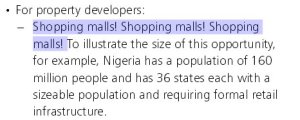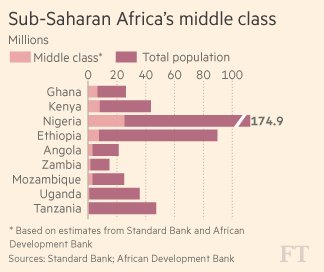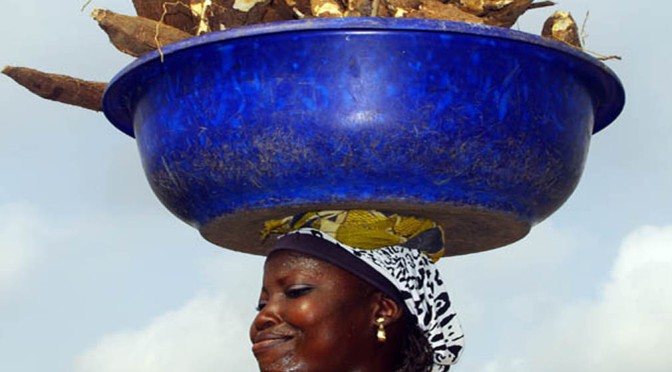I noticed that some of my colleagues from FINCA define themselves as middle class. My boss has recently summarized this: “Take her”, he pointed out X to me, “she is middle class. She has a salary, owns a car, pays taxes, has a pension fund, lives in her own house and has cable internet at home”. He made it sound easy to define a phenomenon that has left others struggling to come to terms with. The middle class is consisting of people who have a tertiary education, live in the city, are interested in politics and have a disposable income.
Where I’m living there are many middle class locals living. They frequent the bakery shop, the beauty salons, the many bars, drive the cars that jam the traffic and buy their food in shopping malls like the one across the road from me. A Deloitte publication is keen to point out the need for formal retail infrastructure in Africa:  “Build Shopping Malls! Shopping Malls! Shopping Malls!” Personally I’d be disappointed to see Dar es Salaam become another sanitized city with interconnected shopping malls.
“Build Shopping Malls! Shopping Malls! Shopping Malls!” Personally I’d be disappointed to see Dar es Salaam become another sanitized city with interconnected shopping malls.
Yet things don’t seem to move as they should. Nestle is citing the less than expected growth of the middle class the main reason for letting go 15% of the workforce in 21 African countries. Tanzania’s middle class is not established as much as in the neighboring countries. In 2010 the African Development Bank had estimated the middle class in Tanzania to be 12% of the population. At the same time it was 44.9 per cent of Kenya’s population, 18.7 per cent in Uganda, 7.7 per cent in Rwanda, and 5.3 per cent in Burundi.
 The Financial Times shows a different picture of the middle class in Tanzania in June 2015: practically non-existant. Hmmm, not sure what’s going on here.
The Financial Times shows a different picture of the middle class in Tanzania in June 2015: practically non-existant. Hmmm, not sure what’s going on here.
Tanzanian politician Zitto Kabwe has written a good article on the topic presenting various metrics in 2013. He doesn’t mention the low percentage of the middle class directly. Instead he offers an explanation that part of the middle class might be hiding in the shadow economy of people not paying taxes or not having social security.
“There is a general consensus that the emergence of middle class in societies is instrumental in the promotion of democratic culture and economic growth. However, conceptualising what entails a middle class has never been a simple black and white exercise. The question remains, who is the middle class?
Economics and social sciences literature does not give a single definition of middle class. Different scholars define middle class from different angles based on their empirical preferences. Generally,
Economics scholars define middle class from an income and consumption approach and social scientists look at it as a social class phenomenon based on access to socioeconomic services. Consequently, there is no single definition of middle class.
This leads to different interpretations and confusions among policy-makers and the public in general as to what entails a middle class.
The social approaches to middle class focus on factors such as levels of education, access to health services, and occupation of an individual. In his Wall Street Journal article (July 5-7, 2013), Francis Fukuyama, a social scientist, argues that ‘middle class is better defined by education, occupation and ownership of assets….’
Banerjee and Duflo (2007) define middle class on the consumption basis arguing that middle class composes of people with daily expenditures between $2 to $10. Benerjee and Duflo also link middle class to democratic values and economic growth through spending on goods and services.
The World Bank and the African Development Bank (AfDB) also define middle class based on the consumption approach. Both banks maintain that Africa’s middle class is composed of people who spend between $2 to $20 a day (i.e. their purchasing power parity falls between this range).
With this definition, it is estimated that 12 per cent of the Tanzanian population falls under the middle class. The AfDB further argues that 34 per cent of Africa’s population is now middle class. Thus showing that Tanzania is below the African average.
Who is the middle class in Tanzania then?
According to ‘Deloitte on Africa’, a middle class person has characteristics like living in an urban area, higher level of tertiary education, salaried job or is small business owner, has fewer children, interested in welfare of his/her family (education and health) and aspirational. 5.5 millions of Tanzanians fall under this category, more or less, depending on where he/she falls between earning/spending $2 to $20 a day.
However, if you consider data from tax authorities and pension funds, these numbers can be questioned. According to the Tanzania Revenue Authority report to the Parliamentary Public Accounts Committee (PAC), there are around 1 million Tanzanians who pay taxes.
There are also around 0.8 million with driving licences (thus with TIN numbers). Data from the Economic Survey shows around 1.1 million Tanzanians being registered with one of the pension funds. NSSF, the only Fund with a Health Insurance scheme, has around 0.6m members.
Members of pension funds are mostly salaried workers and the numbers seem to tally with those of TRA as tax payers because, taxpayers are either salaried workers or entrepreneurs. In light of the above data from TRA and pension funds, it can be concluded that the middle class population in Tanzania is around 1.5 million.
If we include people who are neither members of social security funds nor do they possess TIN such as tax dodgers and successful peasants, there will be many more people in Tanzania with a middle class income without having characteristics of one- in particular the social factor.
Recently, as I was driving along Ocean Road (now Barack Obama Drive) approaching Palm Beach, the traffic was heavy so cars were moving slowly. I saw a young woman selling fresh cassava. I called her to buy one piece. The piece was very delicious and I ordered a second piece. As she was preparing my second piece I decided to pull over and talk to her.
Her name is Salima. Salima wakes up each day at 5 am, sends her 4-year old son to her mother, and walks to catch a Ferry from Kigamboni then a bus to Buguruni to buy cassava. From 8 am to 6 pm she literary walks almost all over Dar City selling her products. She explains that ‘On good days I get up to Sh18,000 ($11.1) profit from a capital of Sh30,000 ($18.5). On bad days I get Sh6,000.’ On the worst days, city council’s paramilitary (mgambo wa jiji) confiscates all her cassava and even beat her up, and she loses everything.
I figured out that she makes an average of Sh10,000 ($6.2) a day from her Sh30,000 ($18.5) daily capital. I asked her if she saves anything. No, was her answer, except that she participates in UPATU (a merry-go-round arrangement) with fellow women in Kigamboni area where she lives. She doesn’t have social security as well. She pays rent of 15,000 ($9.25) a month for her single room. The house has no electricity but it has running water! It is Dar es Salaam, not Kalinzi in Kigoma – 50 per cent of houses in Dar es Salaam do not have electricity.
Based on the definitions above, Salima is a middle class as she earns more than $7 a day. But Salima doesn’t fit into Deloitte on Africa characterisation of a middle class. Salima’s income a month is more than a basic salary of a primary school teacher starting to work. But Salima doesn’t have social security (health insurance), she walks around ten hours a day, and lives in a single bedroom without electricity.
I took that opportunity to educate Salima on the importance of social security, especially having a health insurance for herself and her son. We agreed that she will be saving Sh1,000 ($0.62) every day for her membership to NSSF (Sh30,000 ($18.5) a month).
She got registered with NSSF few days after and everyday she sends to me Sh1,000 ($0.62) through M-Pesa for me to pay her monthly contributions to NSSF. I have paid her contributions 3 months in advance already. She now has social security including health insurance. Does that make her middle class?
Salima lives in Dar (urban). She is young with one child. Salima owns her business and now has a health insurance scheme.
But Salima’s education is primary, and at the time I was talking to her she wasn’t aspirational. She simply survives. I did not ask her if she votes in elections or for her views on democracy.
Is Salima middle class?
Who is the middle class in Tanzania?”
There is an election coming up in October 2015. Like my observation in the Morogoro club, people in Dar also seem to be very much interested in politics and in a fundamental change that will allow them to move up into middle class. Everyone I know has registered to vote in the election.
(source: The Citizen)
(photo by International Institute of Tropical Agriculture on flickr)

Hi Christine, thank for your thought. Upon reflection I must admit that you may be partly right. I still like Thai traditions from 30 years ago and I can see how they have transformed to a modern way of life. The other part is where the heritage architecture and style of living (street food, sidewalk living rooms, greenery around the homes, playing outside) completely disappear to make room for a something else, only to be missed later.
LikeLike
Indeed, how do you define the middle class? Good reflection. With regard to this statement “Personally I’d be disappointed to see Dar es Salaam become another sanitized city with interconnected shopping malls,” I wonder if this is a conflict of an expatriate working in these parts.. wanting to contribute to improved living conditions yet wishing that the rudimentary conditions that hint at the exotic remain the same? Just curious…
LikeLike